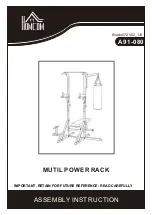
20
Subject to change without notice
Component tester
Specifi c information can be found in ”Controls and Readout“ un-
der COMPONENT/PROBE
35
and COMPONENT TESTER
36
.
The scope has a built-in component tester. The test object is
connected with 4 mm banana plugs. In this mode the Y amplifi ers
and the time base are turned off. Only individual components
may be tested, i.e. they must not be part of a circuit, if voltages
are to be applied to the BNC connectors. If the components are
part of a circuit this must be de-energized and disconnected
from safety ground. Except for the two test leads there may
be no further connection between scope and component. (See
”Tests within a circuit“). As described in section ”Safety“ all
ground connections of the scope are connected to safety ground
including those of the component tester. As long as individual
components are tested this is of no consequence.
The display can only be affected by the controls contained in
the FOCUS/TRACE menu: A-Int., Focus, Trace rotation, HORI-
ZONTAL position.
If components are to be tested which are parts of a circuit or
an instrument those circuits respectively instruments must
fi rst be de-energized. If they are connected to the mains they
must be unplugged. This will prevent a connection between
scope and circuit via the safety ground which may affect the
measurement.
STOP
Do not test charged capacitors.
The principle of the test is very simple: a sine wave generator
within the scope generates a 50 Hz ±10 % voltage which is
applied to a series connection of the test object and a resistor
within the scope. The sine wave proper defl ects in X direction,
the voltage across the resistor which is proportional to the test
current defl ects in Y direction.
If the object contains neither capacitors nor inductors, there will
be no phase shift between voltage and current, so a straight
line will show up which will be more or less slanted, depending
on the value of the object’s resistance, covering appr. 20 Ω to
4.7 kΩ. If there is a short the trace will be vertical, i.e. (almost)
no voltage produces already high current. A horizontal line will
thus indicate an open, there is only voltage but no current.
Capacitors or inductors will create ellipses. The impedance
may be calculated from the ellipse’s geometric dimensions.
Capacitors of approx. 0.1μ to 1000 μF will be indicated.
– An ellipse with its longer axis horizontal indicates a high
impedance (low capacitance or high inductance)
– An ellipse with its longer axis vertical will indicate a low
impedance (high capacitance or low inductance)
– A slanted ellipse will indicate a lossy capacitor or induc-
tor.
Semiconductors will show their diode characteristics, however,
only 20 V
pp
are available, so the forward and reverse characte-
ristics can only be displayed up to 10 V
p
in each direction. The
test is a two-terminal test ,hence it is not possible to measure
e.g. the current gain of a transistor. One can only test B-C, B-E,
and C-E. The test current is only a few mA, so the test will not
harm ordinary semiconductors. (Sensitive devices like delicate
hf transistors etc. should not be tested). The limitation to 10
C o m p o n e n t t e s t e r
Vp with bipolar transistors will suffi ce mostly as usual defects
will show up.
STOP
Attention: Before testing a component, please
check its data to ensure that it would not be over-
loaded by the test voltage of ± 10 V.
The best method to verify whether a component is defective is
the comparison to a good one. If the lettering of a component
is not legible at least it is possible to see whether it is a npn or
pnp transistor or which end of a diode is the cathode.
Please note that reversing the test leads will also invert the
picture, i.e. turn it 180 degrees.
In most cases, e.g. with service and repair, it will be suffi cient
to receive a good/bad result (open, short). With MOS compo-
nents the usual precautions are to be observed, but note, that
except for a possible short MOSFETs and JFETs can not be
suffi ciently tested. Indications to be expected depend strongly
on the kind of FET:
– With depletion type MOSFETs and all JFETs the channel
will conduct if prior to testing the gate was connected to the
source. The Rdson will be shown. As this can be very low it
may look like a plain short although the part is good!
– With enhancement type MOSFETs an open will be seen in
all directions, as the threshold voltage G – S is not available.
With power MOSFETs the anti parallel diode S – D can be
seen.
Tests of components within circuits are possible in many cases
but less indicative because other components may be in parallel.
But also here the comparison with a good circuit might help. As
both circuits must be deenergized it is only necessary to switch
the test leads back and forth between both in order to localize
a defective spot. Sometimes like with stereo amplifi ers, push-
pull circuits, bridge circuits there is a comparison circuit right
on the same board. In cases of doubt one component lead can
be unsoldered, the other one should then be connected to the
ground lead. This is labelled with a ground symbol. The pictures
show some practical examples.
Test Equipment Depot - 800.517.8431 - 99 Washington Street Melrose, MA 02176
FAX 781.665.0780 - TestEquipmentDepot.com
















































